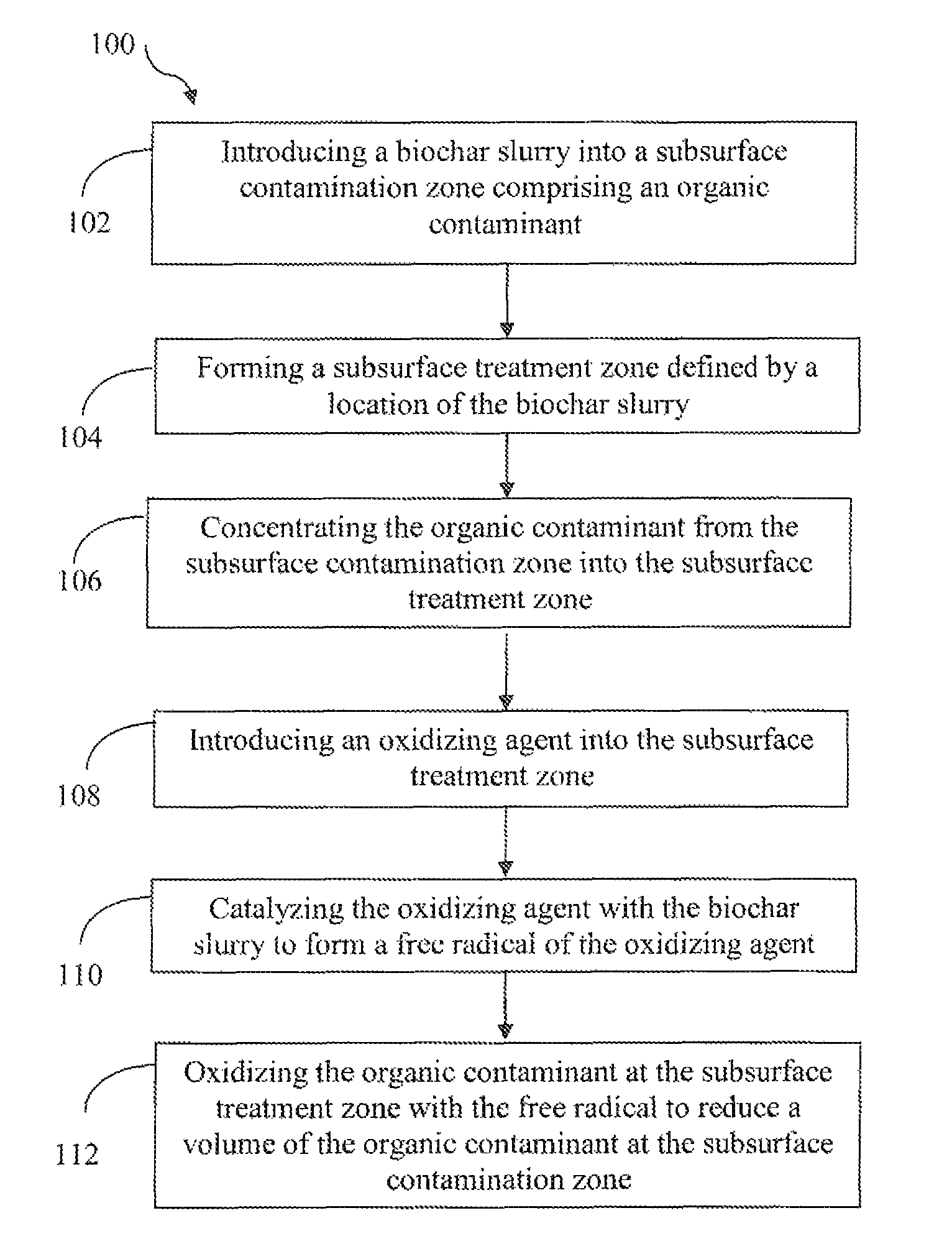Method for the in situ remediation of contaminants
a technology for in situ remediation and contaminants, applied in sustainable biological treatment, biological water/sewage treatment, degassing, etc., can solve the problems of high cost of treatment of such wastewater, large amount of time, and inability to achieve the effect of reducing the volume of organic contaminants
- Summary
- Abstract
- Description
- Claims
- Application Information
AI Technical Summary
Benefits of technology
Problems solved by technology
Method used
Image
Examples
example 1
[0052]In Example 1, five sodium persulfate solutions (oxidizing agents) were made using 100 mL of tap water and 18 g of sodium persulfate. These samples were identified as sample 1-5, as shown below in Table 1. Sample 1 was a control and no additional chemicals were added to this sample. Samples 2, 3, and 4 received biochar doses of 5 g, 15 g, and 25 g respectively. By way of comparison, Sample 5 received 20 μl of 50% sodium hydroxide, which is a known catalyst of sodium persulfate via elevation of pH. The addition of sodium hydroxide to Sample 5 results in a pH of 11, which is sufficient to catalyze the oxidation of sodium persulfate.
[0053]The oxidation reduction potential (ORP) of each sample was recorded at various times over an eleven day period. The results are displayed in Table 1 as normalized ORP values. All ORP values were normalized to the ORP value of 1.00 relative to the Day 0 value of the control, Sample 1.
[0054]
TABLE 1Normalized oxidation reduction potentialBiocharSodi...
example 2
[0056]As was previously identified, dioxanes can be difficult organic contaminants to remove from aqueous solutions, such as in situ remediation of ground water and landfill leachate, due to their relatively high solubility. In Example 2, samples of landfill leachate contaminated with 1,4-Dioxane were obtained for testing. One sample was preserved with sodium bisulfate to inhibit change in the target compounds during the testing period, and the second sample received no preservative. Both samples were treated with 1.5% by weight of wood based biochar. The biochar remained in each vial with the aqueous sample and was sent to a lab for analysis. Analysis for 1,4-Dioxane was completed by using EPA Method 1624 Volatile Organic Compounds by Isotope Dilution gas chromatography and mass spectroscopy, which separates and then detects the compound of interest, namely 1,4-Dioxane. The results of this test are reproduces below in Table 2, which shows that the aqueous concentrations of 1,4-Diox...
example 3
[0058]In situ remediation is also well suited for combating the leaching of volatile organic compounds through groundwater, which can be a significant problem with when dealing with sites contaminated by such organic compounds. In Experiment 3, a sample of soil including various organic contaminants was divided into four 100 gram samples. One sample was left untreated, and marked as the control sample, while the other three each received one dose of a wood based biochar according to the present invention at a rate of 2% by weight. Wood biochar sample #1 included a substantial portion of the biochar particles have a particle size of between 50 microns and 4000 microns. Wood biochar samples #2 and #3 included a substantial portion of the biochar particles have a particle size of between 50 microns and 400 microns, but were obtained from different sources. Each sample was mixed and sent to a lab for analysis. The samples were analyzed using EPA Method 8260B Volatile Organic Compounds b...
PUM
| Property | Measurement | Unit |
|---|---|---|
| particle diameter | aaaaa | aaaaa |
| particle diameter | aaaaa | aaaaa |
| particle diameter | aaaaa | aaaaa |
Abstract
Description
Claims
Application Information
 Login to View More
Login to View More - R&D
- Intellectual Property
- Life Sciences
- Materials
- Tech Scout
- Unparalleled Data Quality
- Higher Quality Content
- 60% Fewer Hallucinations
Browse by: Latest US Patents, China's latest patents, Technical Efficacy Thesaurus, Application Domain, Technology Topic, Popular Technical Reports.
© 2025 PatSnap. All rights reserved.Legal|Privacy policy|Modern Slavery Act Transparency Statement|Sitemap|About US| Contact US: help@patsnap.com

